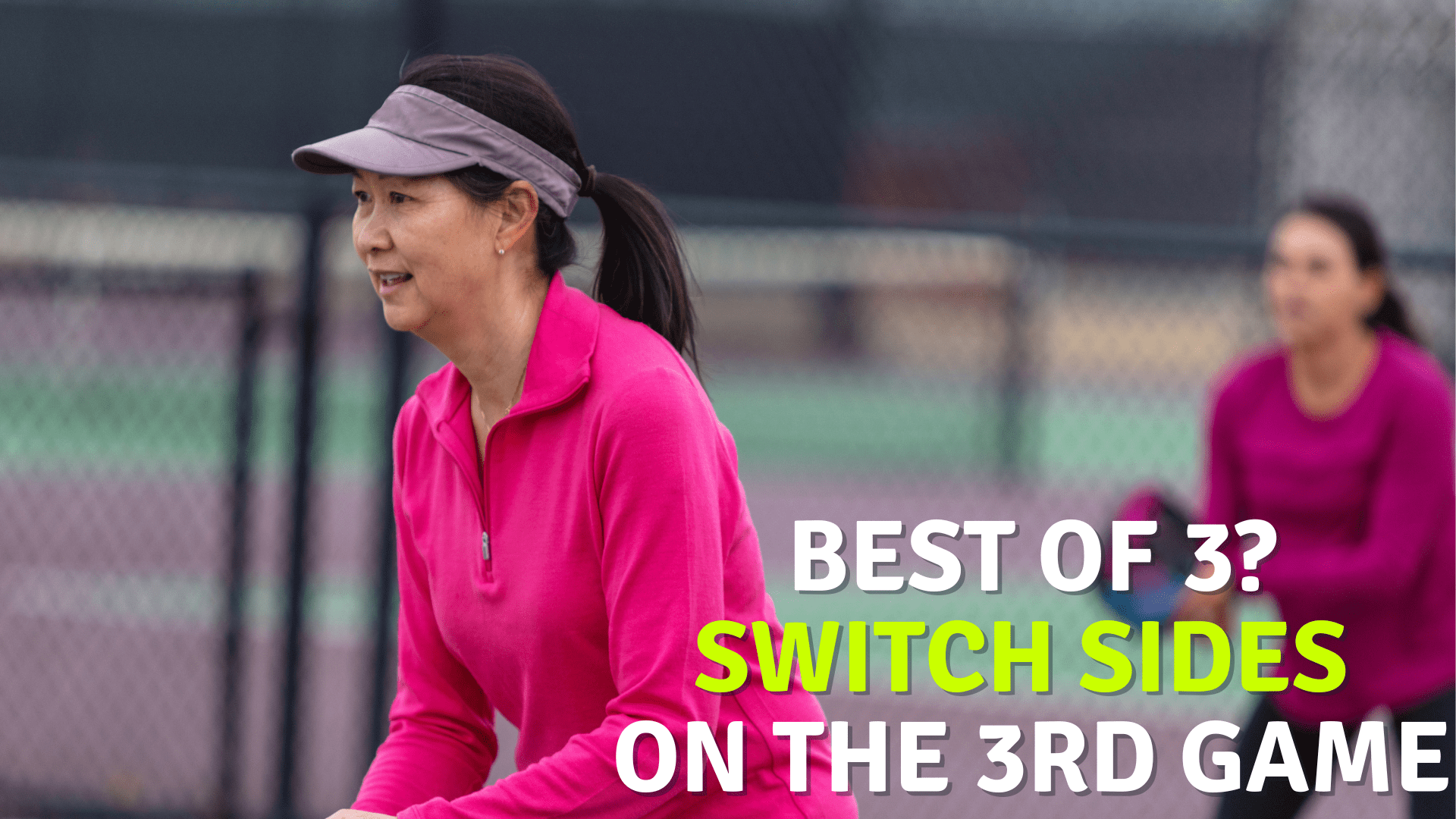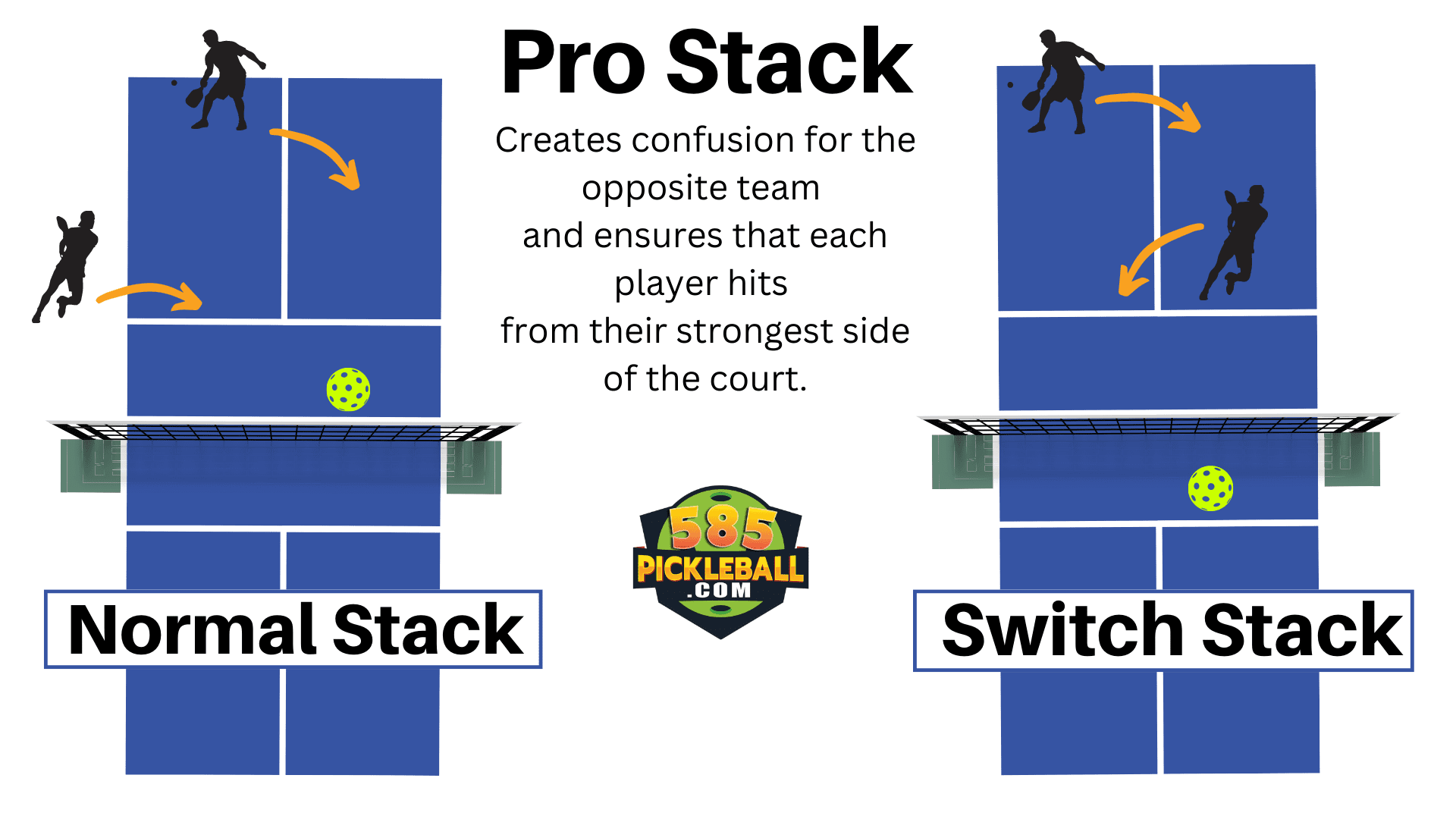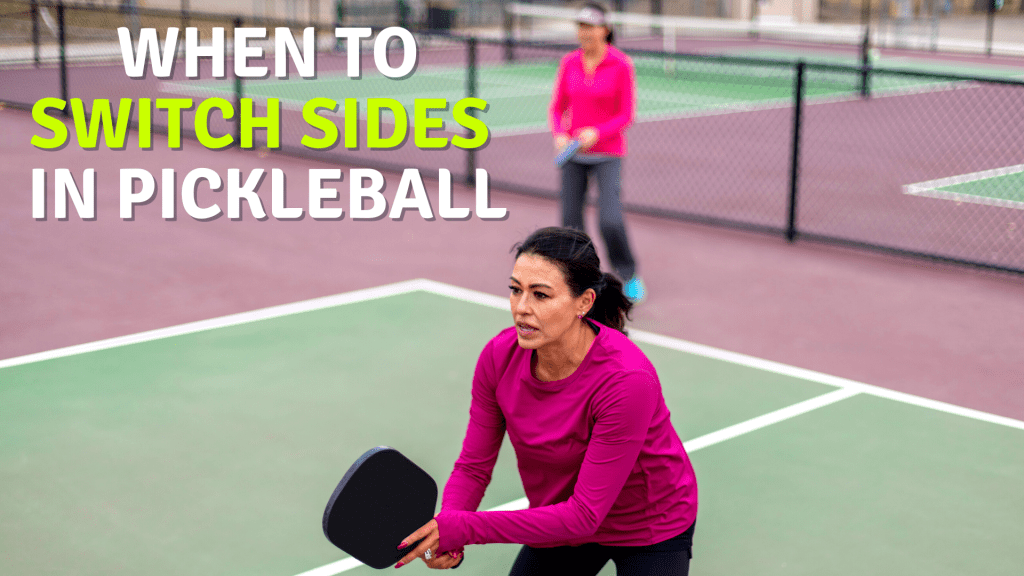Hey, pickle ballers! We wanted to clear up some confusion today about switching sides. So when do you switch sides in pickleball? What is stacking, and when to use it to your advantage? This post will cover the rules and scenarios you may run into on the court. We also want to talk about a strategy that the pickleball pros use: stacking.
The first player or team to score 6 points will switch sides of the court. In a best-of-three game, the players will change again at the beginning of the third game. In a doubles game, the serving team players switch serving sides of the court after every point. This ensures that both players have an equal opportunity to serve and receive from the court’s left and right serving positions.
The post below will explain the full rules, stacking strategies, and how to remember what side to serve from.
Table of Contents
ToggleWhen to Switch Sides in Pickleball
There is some confusion around the word “switching” because it’s used in three different scenarios. Firstly, switching is used when an opposing player or team changes sides of a court after a certain number of points or games. Switching is also used when players move from the left/right or odd/even sides when serving. Furthermore, teammates switch sides during live play and rallies. I will try to be as specific as possible when using the terms for each scenario.
There are a few critical rules to switching sides of the court in pickleball:
-
-
The first player or team to score 6 points will move to the opposite side of the court.
-
-
-
In a best-of-three game, the players will switch sides of the court at the beginning of the match.
-
-
If playing just one game to 21 points, players or teams move to the `opposite side of the court during the consolidation event at 15 points.

What are Consolation Events in Pickleball
A consolation event is when the game reaches 15 points, and both sides have to switch to the opposite court. This is because players have an opportunity to serve and receive from both sides of the court, and this ensures that both players have an equal chance to win the game. Games played to 21 are most common in single-elimination tournaments:
A single-elimination with a consolation bracket is often used in pickleball tournaments. If you lose one game, you can still play in the tournament but will be placed into the consolation bracket, and the games continue until you lose again when you are out of the tournament.
Service Rules For Switching
Serving in pickleball always starts on the right side of the court when the server’s score is even and on the left side when the score is odd. This is an easy way to remember your positioning.
-
-
After each point, the serving team players switch serving positions from left to right until their team commits a fault and has a side-out.
-
-
-
Both players on a team serve before the service is moved to the other side of the court.
-
-
-
The players keep switching sides from right to left to service court opposite, then the next person on that team servers.
-
-
-
Only the serving team switches sides from left to the right, not the receiving team.
-
-
-
At the start of the game, only one serving attempt on the first-serving team. Once a fault is made, the service moves to the opposite team.
-

The Pro Strategy: Stacking in Pickleball
Have you ever watched a professional match and seen them switching around during a rally or on the serve? Well, they’re not just showing off- they’re stacking. Stacking is a common strategy professional players use to give them an advantage on the court. Let’s talk about a few strategies and how they could give you an edge over your opponents and get some team wins.
What is Switching & Stacking In Pickleball
There are two main ways of stacking that we will cover today. You are stacking on the serve and staking on the return. These strategies can effectively gain an advantage over your opponents and hopefully score points. Always communicate with your teammate when using new techniques and methods; you could practice some of these before playing in an actual match.
Stacking on the serve
One pro strategy is to stack on the service. This means that one player will serve from the right side, and their partner will also be on the right. After the service, the serving player would slide to the left side of the court for the return. Why would you use this strategy in the game? This does two things: it creates confusion for the opposite team and ensures that each player is hitting from their strongest side of the court.
The official rules state that a teammate can stand anywhere on or off the court as long as the correct server is serving from the correct side, i.e., you can both be on the same side of the court.
Switch stack
Deceptive as it may sound, this strategy involves not disclosing where you are going on the court to your opponent. Start in a regular formation, and after you serve, both players should switch sides while remaining close to the baseline and awaiting the third shot. Make sure you and your partner are clear about who will switch in front and behind — failing to do so might result in confusion and fault. This gives you an advantage by keeping your opponents guessing and not letting them target a specific player on the return.
Stacking on the return
The same official rules apply to the return stack; if the correct player returning the ball stands on the correct side of the court, their partner can stand anywhere on or off the court. This gives the proper returning player a clear line of sight to hit balls cross-court or down the line.
If you are stacking on the return, once you hit the ball back over the net, your partner slides on the court, and you move to the other side. If you utilize this technique, it’s best to hit high deep returns, so you have enough time to get to the non-volley zone line, and your partner can slide onto the court.
Switch Stack on the Return
Same technique as the switch stack on serve; in this scenario, you wait to return the ball over the net and switch sides with your partner as you approach the NVZ line. This is a great way to confuse your opponent and makes it impossible for them to target a specific player.

Using Hand Signals Effectively
As mentioned above, you must always communicate with your teammate on the pickleball court. Hand signals are an excellent way to signal the stacking strategy you want to implement in the next play.
An open palm usually means “switch,” while a clenched fist typically indicates “stay put.” There may also be a sign for when you want your partner to fake it. Regardless of what that actual sign looks like, agree upon it before the match reducing confusion during gameplay. It’s always good to practice these things with teammates; if you have a regular pickleball partner establishing the hand signal will give you a high level of understanding of your team game.
When using a switching strategy, pickleball hand signals between you and your partner are essential to ensure effective communication. As your team prepares to receive the service, make eye contact with your partner at the non-volley line. This gesture lets their partner know they saw the signal indicating what action to take next.
Conclusion and My Thoughts
If you found this post helpful in understanding pickleball’s rules and strategies for switching sides, then we have done our job right. Always communicate with your partner while playing; it is key to success on the court.
Pickleball is a sport that people of all ages can enjoy. It is a great way to get some exercise and have some fun at the same time. To become a better pickleball player, it is important to practice regularly. This will help you to improve your skills and become more comfortable playing the game. It is also essential to be consistent in your play. Try to stay focused and stay in the moment as much as possible.
What other questions do you have about pickleball? Let us know in the comments below!

